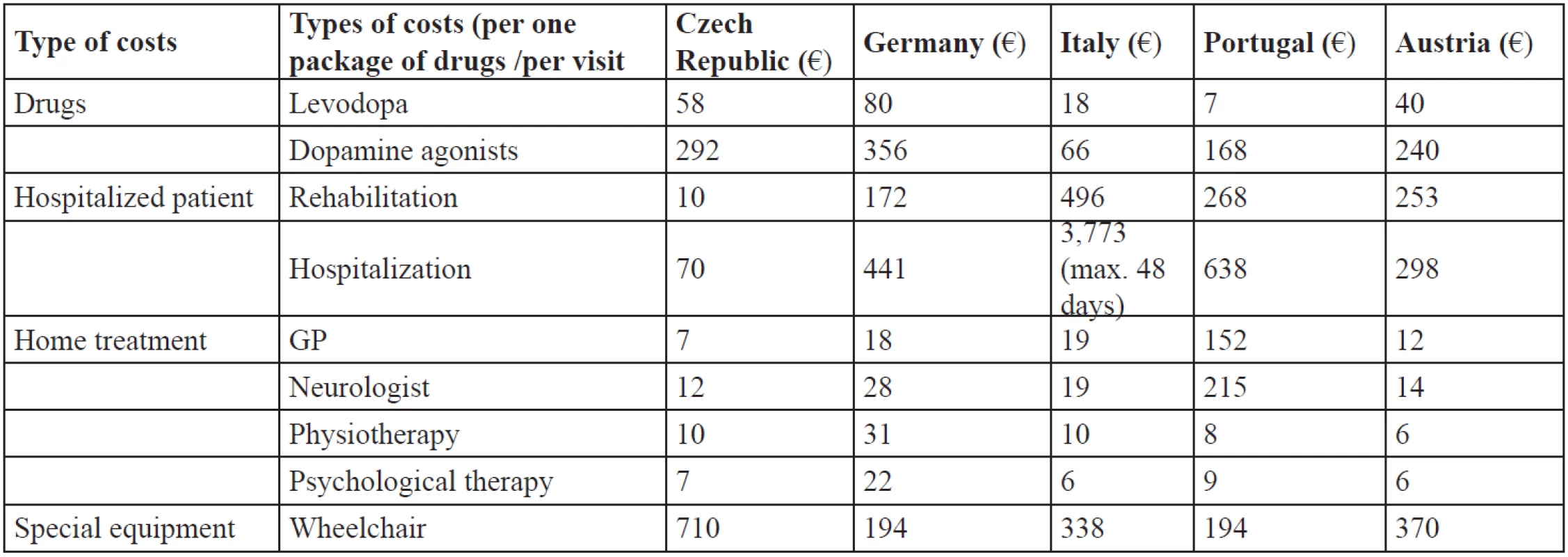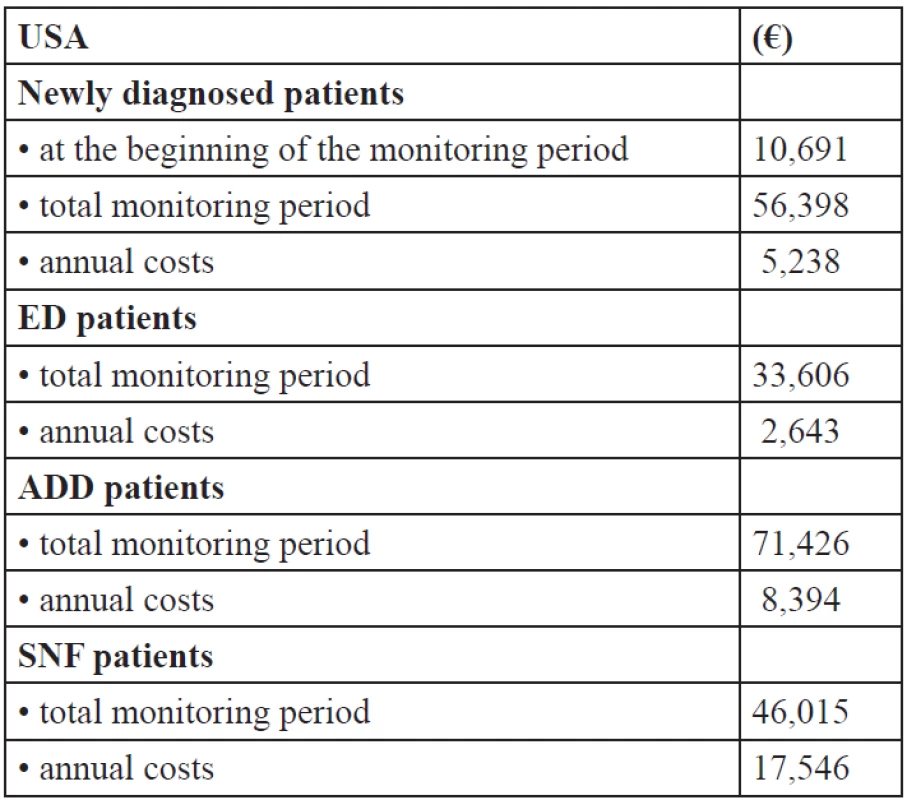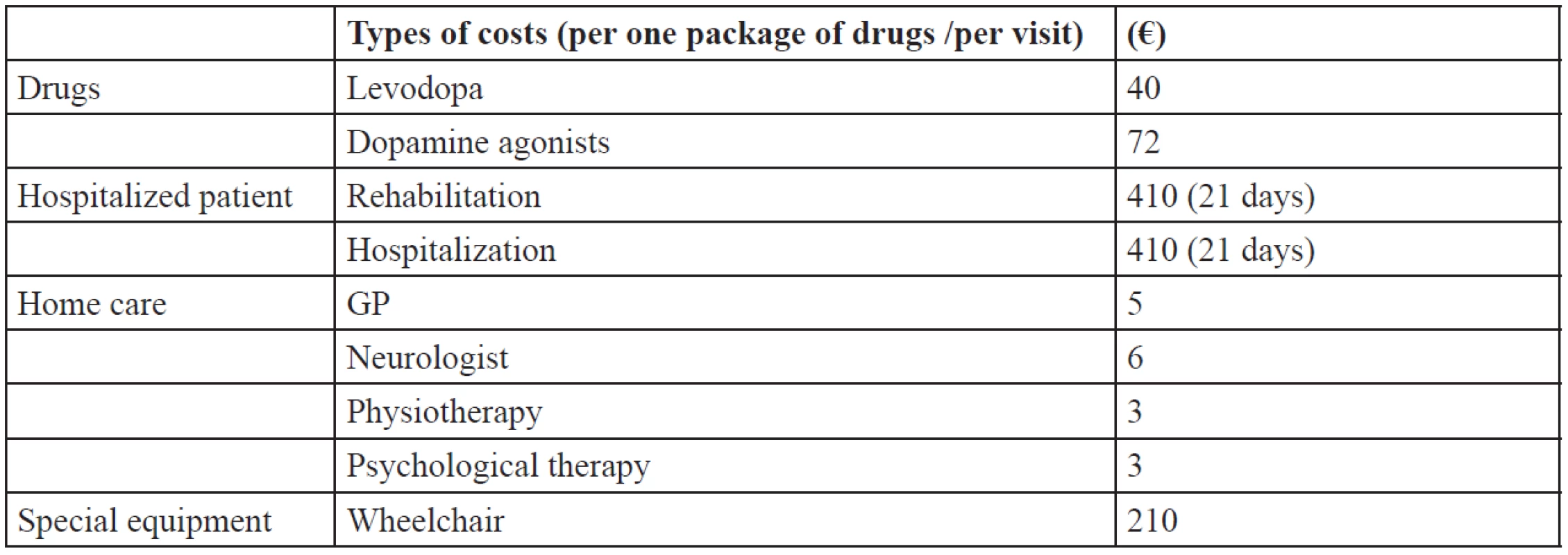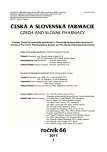Medical and non-medical costs of Parkinson disease – comparison of Europe, USA, Asia an Australia
Authors:
Petra Marešová; Blanka Klímová; Kamil Kuča
Published in:
Čes. slov. Farm., 2017; 66, 3-8
Category:
Original Articles
Overview
At present different kinds of dementia impose a significant economic burden on the whole societies. Parkinson’s disease is the second most common type of dementia. The purpose of this study is to analyze the costs of people suffering from Parkinson’s disease in the context of public expenditure needs for the affected people. Firstly, the treatment costs and care in the selected European countries are analyzed, and secondly, these data are compared with the data from other countries and continents. The focus is not only on the developed economies where the issue of costs and PD already causes significant expenditure from public budgets, but also on the developing economies. The methods applied in this study include a method of literature search of available sources describing the costs of PD and a qualitative comparative analysis method. The findings show that the data from the European countries range between 1,949 € and 12,054 €. Comparable data are in the USA at 17,064 €, in Australia at 7,020 € and in Asia they range between 649 € and 9,544 €. These values are certainly connected not only with the available data, but also with the level and possibilities of healthcare services in these countries. In addition, GDP for these continents and countries was specified and the cost ratio of patient with respect to GHD per capita was described. This calculation provides an orientation relative indicator about the economic burden with respect to the country’s development. The results indicate that the most significant issues are diseases and treatment in the European countries in which their highest incidence is expected in future.
Key words:
Parkinson’s disease • costs • health care • analysis
Introduction
Parkinson’s disease (PD) is among the main types of dementia increasingly occurring among older generation groups in the developed countries where it represents a growing economic burden of public budgets1–4). Figure 1 below illustrates the incidence of PD in the world. The monitored variable is the death rate per 100,000 people. The red color represents the death rate of 4.6–3 per 100,000 people, the green color 2.99–1.85, the purple color 1.82–0.8. The grey color represents the death rate below 0.8. The indicator specifies two basic realities; the incidence of PD and effective treatment. In the developed countries there is a high prevalence (USA, Europe), while in the developing countries there is a problem with the treatment costs (Africa). Relatively, the best situation is in the Asian countries. Specifically, in the European countries 1.2 million of people have Parkinson’s disease, which approximates to: 260,000 in Germany, 200,000 in Italy, 150,000 in Spain, 120,000 in UK and 117,000 in France. This equates to a rate of more than 1 per 1,000 people in Europe, making it the second most common neurodegenerative disorder5). The projected worldwide increase in prevalence of Parkinson‘s disease should be 8,7 mil. in 20306).

A significant difference was seen in prevalence by geographic location only for individuals 70 to 79 years old, with prevalence of 1,601 in individuals from North America, Europe, and Australia, compared with 646 in individuals from Asia (P < 0.05). A significant difference in prevalence by sex was found only for individuals 50 to 59 years old, with a prevalence of 41 in females and 134 in males (P < 0.05). PD prevalence increases steadily with age. Some differences in prevalence according to the geographic location and sex can be detected7, 8).
The purpose of this study is to specify costs of drugs and care about the ill people in the countries with the highest incidence. The results are compared and discussed with the expenditure in other countries, particularly with respect to the economic situation of these countries.
Nowadays, the commonly used method for the assessment of costs is the Cost-of-Ilness (COI). COI method is especially suitable for the evaluation of costs of chronic diseases that are significantly connected with health expenditure. To perform a COI study, it is necessary to define disease, epidemiological approach, type of costs, and study perspective. Consequently, resource consumption data and unit costs can be collected, and the results presented and methodically discussed, in conjunction with sensitivity analysis to test their robustness9, 10). The key for the specification of the costs are the selected studies based on this approach.
Experimental part
The methods applied in this study include a method of literature search of available sources describing the costs of PD. In addition, to compare costs of treatment and care of the PD patients, a qualitative comparative analysis method was used. It has been a common method used in many scientific disciplines during the past two decades. This method uses basic logic and set-theoretical concepts for analyzing complex causal relations. In some cases, the costs were recalculated and specified with respect to the individual stages of this disease.
This study focuses on the treatment costs of patients affected by PD. It should serve as a complex cost analysis from different countries of the world. It is based on available studies and articles dealing with the costs that were studied from different points of view such as comparisons of the selected countries or comparison of costs between the patients with PD and healthy people of the same age group. The information was presorted and served as a suitable material for this analysis. The study uses information of European, Asian and US and Australian case studies.
The main attention is focused on the costs in Europe and in the USA, where the issue of aging population and rising number of people with dementia is the most current. There are currently 48 states in Europe. The selected countries include: England, Germany, Italy, Austria, Czech Republic, Portugal, and Sweden. The basic form of the health system is the same in all European countries. The countries listed above were selected with respect to the topicality, availability and comparability of the data. America is specific in its different approach to the health system, however, the issue of dementia is also essential there. Most studies have been conducted in the USA and countries of South America; some from them were selected and used in this analysis. This issue of PD is also important in Australia. Therefore, the costs on this continent are specified, too. On the Asian continent, this issue, with respect to the age structure, is not that much topical. Nevertheless, the treatment costs are described in order to illustrate the situation in Russia, China, India and Korea.
Results
Economic burden of PD in chosen European countries
Nine data were selected to compare individual items in seven selected countries (Fig. 2).
Compenhausen (2011)12) conducted research in six European countries was funded by the European Commission and its program FP5. In addition, the non-profit organization EuroPa played an important role in this research. EuroPa forms a network of cooperating medical centers dealing with the research and treatment of PD5). The register comprises 1,821 patients diagnosed with PD. These patients were randomly chosen out of ten European centers between 2003 and 2005.The costs were calculated per one patient as average costs for the period of a six month monitoring and they were recorded in local currency and consequently, converted into Euros with purchasing power parity. The costs were divided into the direct and indirect costs. The direct costs were than divided into the treatment of the hospitalized patients, home patients, costs of PD drugs and costs of care, which was divided into formal (provided by a professional caregiver) and informal (provided by family members)12). In Portugal and Austria almost 14% of patients were provided professional care (from one hour up to 73 hours a week), while in the remaining countries it was only 8% of patients. The costs of formal care ranged between 60 € in Portugal and 1060 € in Italy for the monitored period. Most of the consultations was performed in the Czech Republic, the fewest in Portugal, which results from the fact that a number of neurologists per 100,000 people from 2010 on the basis of this study is approximately 13.2 in the Czech Republic, while in Portugal it is 3.2 per 100,000 people and the costs of consultations at the doctor were 18 times or even 22 times higher than in the Czech Republic.
Winter specific summary of direct costs was also made by Winter et al. (2010)11). This study uses information obtained from the register of EuroPa and primarily focuses on the patients in the Czech Republic. This study analyzes and compares results with the direct costs in Germany, UK, and Sweden. The target groups were the patients in home care, diagnosed with PD. The direct costs included hospitalization, rehabilitation or home care, costs of additional therapy (physiotherapy, staffing therapy), costs of drugs, costs of special equipment and formal care (professional care). The costs of informal care (by family members) were calculated on the basis of incomes of the key caregivers. This is the net income after deducting mandatory costs such as income tax or social benefits. The direct costs also include payments made by patients such as payments for drugs and special equipment.
Study in Hungary by Tomas et al. (2015)14) specifies mean costs € 6030.2 (SD = 6163.0)/patient/year (direct medical 35.7%, direct non-medical 29.4%, indirect costs 34.9%).
Table 1 present the prices of individual costs in the selected countries. For example, in the Czech Republic the highest costs are spent on the specialized equipment; a wheel chair costs 710 €, on the contrary care of the hospitalized patient the least costly in comparison with the remaining four states. The counterpart is Italy where the costliest is the hospitalization of a patient and his/her rehabilitation, while the drugs are the least costly. In Portugal and Austria almost 14% of patients were provided professional care (from one hour up to 73 hours a week), while in the remaining countries it was only 8% of patients. The costs of formal care ranged between 60 € in Portugal and 1060 € in Italy for the monitored period. Most of the consultations was performed in the Czech Republic, the fewest in Portugal, which results from the fact that a number of neurologists per 100, 000 people from 2010 on the basis of this study is approximately 13.2 in the Czech Republic, while in Portugal it is 3.2 per 100,000 people and the costs of consultations at the doctor were 18 times or even 22 times higher than in the Czech Republic.

Treatment costs of PD in the USA
In the USA this disease affected between 340 and 645 thousand people in 201115). The total medical costs of PD treatment were estimated at 23 billions of dollars per year with an annual economic burden at 17,389–21,050 € of the direct costs per patient. Research studies by Kaltenboeck et al. (2012)16) and Suh et al. (2012)15) specify these data. These are two independent studies exploring the treatment costs of PD in the USA. In the first case the data of the American government from the insurance system Medicare were used. They analyzed different direct costs for patients in relation to the individual phases of PD. Kaltenboeck et al. (2012)16). In the course of five years four groups of people were defined. They include newly diagnosed patients (ND), patients in the early stage of the disease (ED), patients who use assistive equipment such as a wheelchair or a walker (AAD), and patients who require professional treatment (SNF). Altogether 25,577 patients were divided into these four groups. The average age was 76 years. Table 2 presents a comparison of costs in these groups.

These groups were monitored for five years and the data were collected between 2004 and 2009. The data show that with the increasing stage of the disease, the costs were multiplying even 3.5 per year.
The second study15) (of 2012 mainly explores assessment of the economic burden of patients. The data were provided from the database of the health insurance company and clinic Medstat. The database included records of patients having a private insurance for medical services and drugs for a five year monitoring period, from the January of 2004 till the December of 2008. These medical services were both for the patients in home care and hospitalized patients. The data of the patients with home care contained information about the visits at the doctor’s office, emergency or other institutions. The study excluded patients younger than 18 years or those who did not possess any insurance for the first years. Altogether 8,549 patients were selected. The treatment costs including medical costs such as hospitalization, or visits at the emergency and the costs of the prescribed drugs were calculated per one patient per year. The treatment costs were divided into the costs directly related to PD and the costs non-related to PD. Approximately a half of the monitored patients was taking an average dose of levodopa between 300 and 600 mg. As far as the costs are concerned, patients noticed a significant increase of their total costs at the beginning and at the end of the monitoring period, which might be connected with the costs of drugs.
Costs of PD in the Asian countries
Although the prevalence of PD in Asia is not very high at the moment, there are certain implications of its increase in future. At present, the most populous countries are China, India, Indonesia, Pakistan, Bangladesh, and Japan and the number of PD patients in these counties is expected to increase from 2.57 million in 2005 to 6.17 million in 20306). While the occurrence of PD appears to be slightly less common among the Asians compared to the Caucasians, there does not appear to be a significant difference in rates between the Chinese, Malays and Indians living in Singapore. The rates of occurrence of PD in Japan (Yonago City) also appear to be stable over the past 25 years. Nevertheless, the burden of PD in Asia will rise significantly in the years to come as a result of an increased life expectancy and an ageing population. There is therefore a need to train more doctors and health care professionals in the region to better manage and care for the increasing numbers of PD patients For example, the costs per one patient were in India calculated at 649 € in 200915). In China this was slightly higher – 842 €, and in Russia even 3, 510 €. Table 3 illustrated the selected types of direct costs such as costs of drugs, hospitalization, special equipment and home care for Russia.

The data on the PD treatment costs are also available from South Korea. The purpose of this research was to analyze social-demographic characteristic, use of health services and calculation of the direct medical costs of the PD treatment based on the data from the database of the Korean National Health Insurance. The patients with primary or secondary designation of PD were selected according to the Korean standard classification. Altogether 4,137 people suffered from PD. The average age was 71.6 years and females formed approximately 60% of patients. On the basis of a one-year-long monitoring period, the patients in home care consulted their doctor 9.83 days and the hospitalized patients spent on average 25.3 days in hospital. The annual direct costs on the patients in home care were 445 € per person and 9,544 € per hospitalized patient19).
Australia
An Australian study of 2005 deals with the treatment of patients with PD in Sydney. The study indicates that Sydney might have one of the highest prevalence of PD in western world. Out of the people who were older than 55 years, 776 per 100,000 appeared to suffer from PD, which is rather high)18). The purpose of another Australian study Cordato (2005)17) was to determine the costs spent on the treatment of patients with PD and compare them with the costs of healthy people of the same age group. The study consisted of six males and six females suffering from PD. The average age was 71.3 years. Nine out of these 12 patients reported to have someone of the family as their caregiver (eight partners and one daughter). The study shows that the quarterly costs of health care reached 1,153 €. The biggest proportion of the costs was formed by the costs of drugs (approx. 36% of the total costs). Apart from the costs of drugs, this number included the costs directly connected with the treatment (physiotherapy, hydrotherapy, massages, or psychological therapy). Table 4 specifies the patients‘ costs. The total direct costs of treatment annually reached 4,612 € per person.

Discussion
The data from the European countries range between 1,949 € and 12,054 €. The difference consists in the costs of care in the indirect costs. America is specific in its different approach to the health system, however, the issue of dementia is also essential there. Most studies have been conducted in the USA and countries of South America.
Also comparable data are in the USA (average value from two studies) at 17,064 €, in Australia at 7,020 € and in Asia they range between 649 € and 9,544. The situation in Australia is comparable with average costs in the European countries and the costs in Asia are lower. On the contrary, the US study by Suh et al. (2012)15) showed a high burden in comparison with other countries. The reason is a big amount of the included costs and especially the costs on the hospitalized patients.
Average costs of patient per year were calculated to describe the economic burden of individual continents. In Europe, Asia and ASA the average costs were calculated on the basis of available studies. The Australian data remained unchanged (Table 5).

In addition, GDP for these continents and countries was specified and the cost ratio of patient with respect to GHD per capita was described. This calculation provides an orientation relative indicator about the economic burden with respect to the country’s development. The results indicate that the most significant issues are diseases and treatment in the USA and European countries in which their highest incidence is expected in future.
The calculation stated above is slightly misleading especially in the area of calculating costs on patient per year where the average value does not solve the exact composition of costs in the selected studies. Better specification is of course the aim of national strategies in the fight against dementia. Therefore, higher availability of the exact results can be expected in future, which can result in better readiness for increased expenditure in future.
Acknowledgement
This study is supported by internal project SPEV No. 2103 Investment under concept Industry 4.0 at Faculty of Informatics and Management, University of Hradec Kralove, Czech Republic. In addition, authros thank to Michal Hruska for his help with the research.
Conflict of interest: none.
Received: November 6, 2016
Accepted: January 3, 2017
doc. Ing. Mgr. Petra Marešová, Ph.D.
University of Hradec Kralove
Faculty of Informatics and Management, Department of Economics
Rokitanského 62, 500 03 Hradec Králové 3, Czech Republic
Faculty of Medicine, University of Ostrava
Dvořákova 7, 701 03 Ostrava, Czech Republic
e-mail: petra.maresova@uhk.cz
B. Klímová
University of Hradec Kralove, Czech Republic
Faculty of Informatics and Management
K. Kuča
University of Hradec Kralove, Center for Basic and Applied Research
University Hospital Hradec Kralove, Biomedical Research Center, Czech Republic
Sources
1. Marešová P., Klímová B., Kuča K. Alzheimer’s disease: Cost cuts call for novel drugs development and national strategy. Čes. slov. Farm. 2015; 64, 25–30.
2. Maresova P., Mohleska H., Kuca K. Social and family load of Alzheimer’s disease. Applied economics 2015; 48 (21), 1936–1948. doi:10.1080/00036846.2015.1111986
3. Mohelska H., Maresova P., Valis M., Kuca K. Alzheimer’s disease and its treatment costs: case study in the Czech Republic. Neuropsychiatric Disease and Treatment 2015; (11), 2349–2354. doi:10.2147/NDT.S87503.
4. Mohelská H., Marešová P. Economic and managerial aspects of Alzheimer’s disease in the Czech Republic. In: Procedia economics and finance. Amsterdam: Elsevier 2015; 521–524.
5. The European Brain Council (EBC). Parkinson’s disease Fact Sheet 2011. Available at: http://ebc-brussels.org/wp-content/uploads/2015/07/Parkinsons-fact-sheet-July-2011.pdf (accessed 20. 11. 2015).
6. Statista. Projected worldwide increase in prevalence of Parkinson’s disease in 2005 and 2030. 2015. Available at: http://www.statista.com/statistics/215459/projected-worldwide-increase-in-prevalence-of-parkinsons-diseas/ (accessed 20.11. 2015).
7. LeDuc Media. 2015. Parkinson disease. Available at: http://www.worldlifeexpectancy.com/cause-of-death/parkinson-disease/by-country/(accessed 20.11. 2015).
8. Pringsheim T, Jette N, Frolkis A, Steeves TD. The prevalence of Parkinson’s disease: a systematic review and meta-analysis. Mov Disord. 2014; 29(13), 1583–1590. doi:10.1002/mds.25945
9. Findley L., Aujla M., Bain P. G., et al. Direct economic impact of Parkinson’s disease: a research survey in the United Kingdom. Mov Disord. 2003; 18, 1139–1145.
10. Hagell P., Nordling S., Reimer J., Grabowski M., Persson U. Resource use and costs in a Swedish cohort of patients with Parkinson’s disease. Mov Disord. 2002; 17, 1213–1220.
11. Winter Y., Campenhausen S., Brozova H., et al. Costs of Parkinson’s disease in Eastern Europe: A Czech cohort study. Parkinsonism 2010; 16(1), 51–56. doi:10.1016/j.parkreldis.2009.07.005.
12. Campenhausen S., Winter Y., Rodrigues A., et al. Costs of illness and care in Parkinson’s Disease: An evaluation in six countries. European Neuropsychopharmacology 2011; 21(2), 180–191. doi:10.1016/j.euroneuro.2010.08.002
13. Spottke A. E., Reuter M., Machat O., Bornschein B., von Campenhausen S., Berger K., et al. Cost of illness and its predictors for Parkinson’s disease in Germany. Pharmacoeconomics 2005; 23, 817–836.
14. Tamás G., Gulácsi L., Bereczki D., Baji P., Takáts A., Brodszky V., et al. Quality of life and costs in Parkinson’s disease: a cross sectional study in Hungary. PLoS ONE 2014; 9(9), e107704. doi:10.1371/journal.pone.0107704
15. Suh D. Ch., Pahwa R., Mallya U. Treatment patterns and associated costs with Parkinson’s disease levodopa induced dyskinesia. Journal of the Neurological Sciences 2012; 319(1–2), 24–31. doi:10.1016/j.jns.2012.05.029
16. Kaltenboeck A., Johnson S. J., Davis M. R., et al. Direct costs and survival of medicare beneficiaries with early and advanced parkinson’s disease. Parkinsonism 2012; 18(4), 321–326 doi:10.1016/j.parkreldis.2011.11.015
17. Cordato D. J., Schwartz R., Abbott E., et al. A comparison of health-care costs involved in treating people with and without Parkinson’s disease in Southern Sydney, New South Wales, Australia. Journal of Clinical Neuroscience 2006; 13(6), 655–658. doi:10.1016/j.jocn.2005.09.006
18. Chan D. K., Cordato D., Karr M., et al. Prevalence of Parkinson’s disease in Sydney. Acta Neurol Scand. 2005; 111, 7–11.
19. Kwak M. Social demographic characteristics and direct medical costs for patients with Parkinson’s disease in Korea: big data analysis from the national health insurance claims dataset. Value in Health 2015; 18(7), A751. doi:10.1016/j.jval.2015.09.2906
20. OECD 2016. Available at: https://www.oecd.org/ (accessed 20. 11. 2015).
Labels
Pharmacy Clinical pharmacologyArticle was published in
Czech and Slovak Pharmacy

2017 Issue 1
Most read in this issue
- The fate of Jewish pharmacists from the Czech Lands during the holocaust
- Medical and non-medical costs of Parkinson disease – comparison of Europe, USA, Asia an Australia
- Self-emulsifying drug delivery system (SEDDS) of Ibuprofen: formulation, in vitro and in vivo evaluation
- Cytotoxic, anti-cancer, and anti-microbial effects of different extracts obtained from Artemisia rupestris
